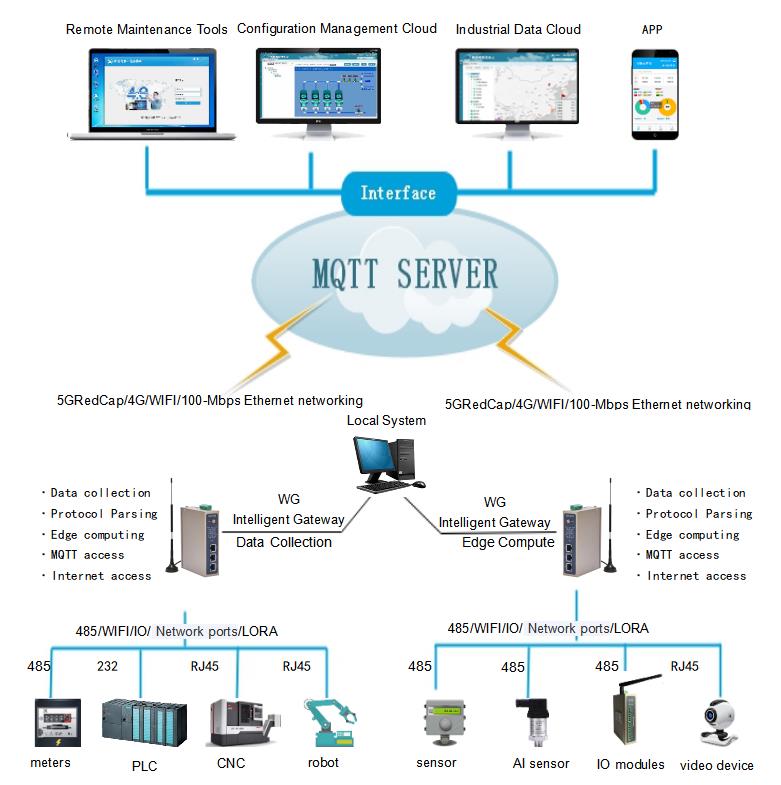-
What Are the Roles of Industrial Internet of Things Gateways (IIoT Gateways) in the Era of Industry 4.0?
2025-08-28 17:25:58
The era of Industry 4.0 is characterized by intelligence and informatization, aiming to elevate the intelligence level of manufacturing and construct adaptive, resource-efficient smart factories.
Its technological foundation lies in network systems and the Internet of Things (IoT) framework.Complex and diverse industrial sites often present challenges in integrating various systems, interfaces, protocols, software, and platforms.
IIoT gateways play a pivotal role as bridges connecting industrial equipment and cloud platforms. They collect data from various devices, perform standardized preprocessing, and then transmit it to the cloud for further display, storage, and analysis. This provides robust support for enterprises to achieve intelligence, automation, and data-driven decision-making.Market Demand for IIoT Gateways
-
Connecting Unconnected Devices: Many enterprises are upgrading their traditional equipment with sensors and controllers, a process that requires IIoT gateways to perform necessary protocol and data conversions and transmit the data to cloud platforms.
-
Migration of Software Applications to the Cloud: Companies pursuing digital transformation are relocating key applications and computing resources to the cloud.
IIoT gateways are gradually becoming communication hubs between the field and the cloud, while also enabling some applications to run locally on the gateway. -
Enhanced Hardware and Algorithms: New-generation enhanced gateways, equipped with embedded multi-core processors, artificial intelligence chipsets, and edge computing algorithms, enable faster and more secure data processing and transmission.

Wutongbolian's Industrial IoT Gateways offer versatile industrial equipment connectivity and data acquisition capabilities, including PLCs, sensors, CNC machine tools, industrial robots, and instrumentation.
They transmit data to cloud platforms or upper computers via 5G/4G/WIFI/Ethernet, effectively supporting remote monitoring, fault handling, remote maintenance, and data analysis.Key Functions of IIoT Gateways
-
Data Acquisition and Protocol Conversion: Sensors, meters, PLCs, and other devices in the industrial field connect to Wutongbolian gateways via serial or network ports.
The gateways can adapt to the communication protocols of field devices, such as Modbus RTU, Modbus TCP, and OPC, and provide flexible internet access options like 5G, 4G, WIFI, and Ethernet for real-time communication with multiple devices. -
Edge Computing and Standardized Processing: Industrial IoT gateways support various edge computing functions, including intelligent acquisition, data filtering, alarm calculation, change triggering, formula calculation, and grouping strategies.
By standardizing device data, they significantly reduce the pressure on cloud service centers, enhancing system stability and high concurrency, and facilitating integration with platforms like MES and ERP. -
Multi-Network Inter-Backup and Discontinuation Resumption: When network quality is poor, gateways automatically switch to higher-quality communication networks.
Additionally, they support local data storage, allowing them to temporarily store data during network outages and resume uploading from the data breakpoint once communication with the platform is restored, ensuring data integrity and real-time performance. -
Remote Maintenance and Configuration Management: Gateways can be configured locally and remotely to ensure normal service provision. For PLC devices requiring remote maintenance, gateways enable remote programming, debugging, and program uploading and downloading for异地 (remote) PLCs, avoiding travel and additional expenses while effectively improving work efficiency.
-



 Go Top
Go Top